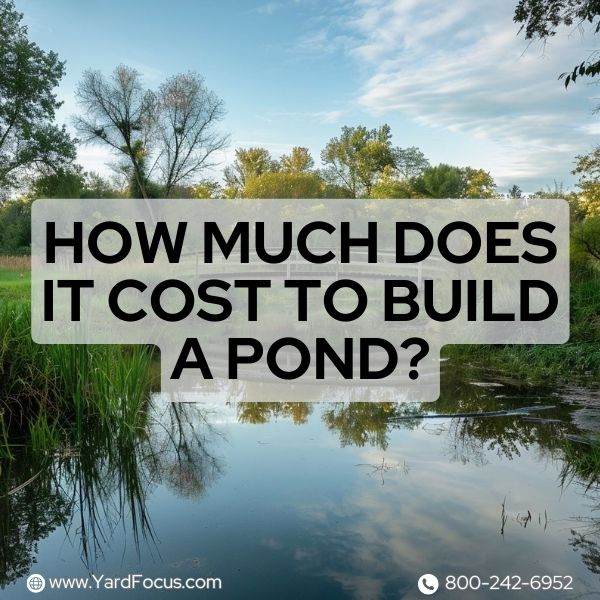
How Much Does it Cost to Build a Pond?
Building a pond is on the wish list of many homeowners and knowing how much does it cost to build a pond is an important question.
The cost to build a pond can vary widely based on factors such as size, location, design, and the materials used.
It's advisable to consult with local professionals for the most accurate and up-to-date estimates tailored to your specific project needs.
This article aims to break down those costs and what factors affect them, making it easier for you to plan your budget.
Get ready to make a splash with your new project!
Factors Influencing the Cost of Building a Pond
Many things can change how much it costs to build a pond. The size, location, and materials all play a big part in setting the price.
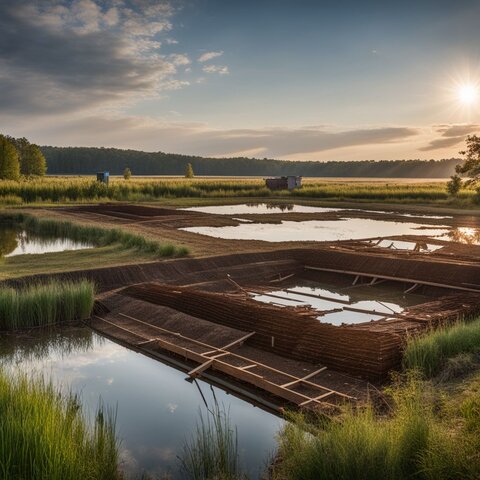
Size of the Pond
The size and depth of your pond play a huge role in how much you'll spend. Bigger ponds require more digging, which raises excavation costs.
For very small backyard ponds, some homeowners may opt to do the excavation work manually, though this approach is labor-intensive and may not be suitable for larger or more complex pond designs.
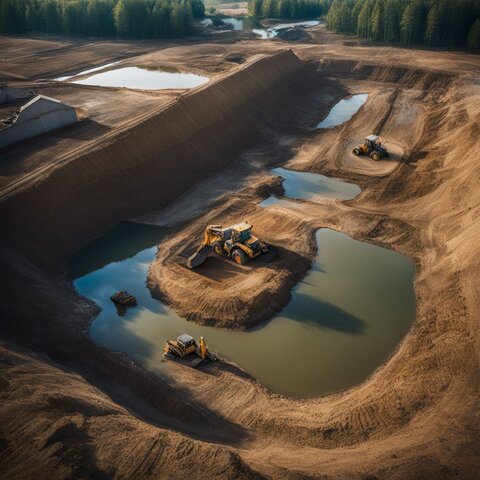
Labor costs for excavation can vary widely based on regional rates and the specifics of the job, so it's best to consult with local professionals for accurate estimates.
The disposal of excavated soil or rocks represents an additional cost that can vary widely based on local disposal fees and the amount of material to be removed.
It's important to obtain a local estimate for these services. Planning ahead for these costs ensures no surprises as your pond takes shape.
Pond Type
The cost of building a pond is significantly influenced by the type of pond you choose.
Above-ground ponds can be less costly to install than in-ground ponds, such as koi ponds or larger recreational ponds, due to differences in construction requirements and materials.

Artificial lakes and natural swimming ponds typically require larger spaces and more intricate construction, often resulting in higher costs compared to simpler pond designs.
Costs also vary based on whether you prefer a garden pond filled with aquatic plants or a functional fish farm.
Liner materials play a big part in determining your pond’s price.
Flexible liners like HDPE, PVC, RPE, and EPDM are popular choices for varying types of ponds due to their durability and flexibility.
Preformed drop-in liners offer convenience but might limit your size and shape options.
Each type comes with different prices, so consider what fits best within your vision and budget before deciding.
Pond Location
Selecting an optimal location for your pond that minimizes excavation and construction challenges can significantly impact the project's overall cost.
Some areas might need more work to get ready, like clearing trees or moving rocks. This can add to your costs.
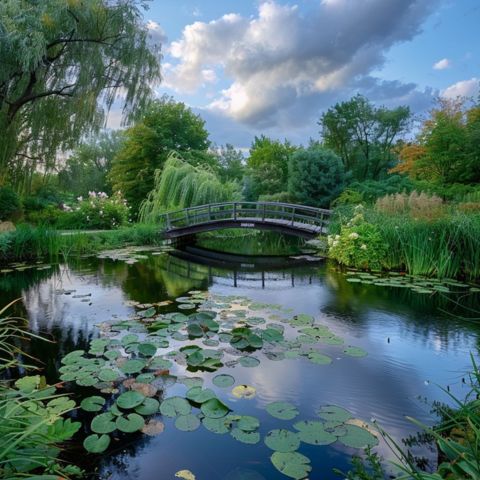
If you pick a place that's easy to dig and doesn't have many obstacles, you'll likely spend less money.
Places near buildings or under trees usually mean more work to avoid damage and ensure proper sunlight reaches the water.
The closer the site is to electrical sources for pumps and filters, the cheaper it will be to install necessary equipment.
Consider local zoning laws too; they can affect where you can build your pond and may involve permit fees.
Excavation Requirements
The cost of excavation is influenced by a variety of factors including pond size, depth, and the nature of the site's soil and terrain, making it important to get a detailed estimate based on your specific project.
The cost of manually excavating a small pond can vary, so it's advisable to consult local professionals for labor rates in your area, as these can differ significantly.
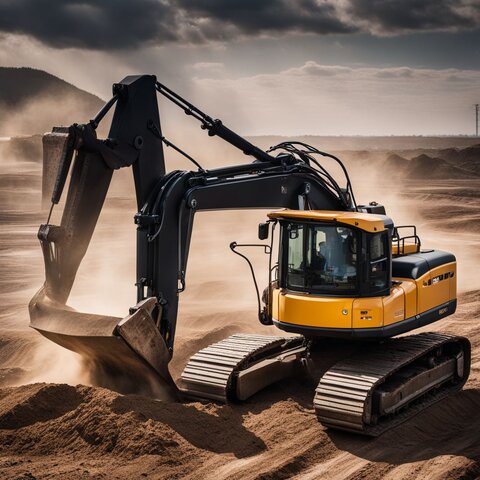
For larger ponds, professionals with special equipment may charge between $60 and $200 per cubic yard or an hourly rate of $55 to $150.
Removing excess dirt from your property will add another cost of about $105 to $175 per cubic yard.
Hauling away dirt isn't the only expense; regrading or resloping might be necessary, especially for above-ground ponds.
The excavation stage is crucial in pond building because it influences both the final look and stability of the pond structure.
Soil tests may also determine if additional materials are needed to support your chosen liner material effectively.
Geographic Location
For the most accurate cost estimate, consult with pond construction professionals in your area who are familiar with local regulations, labor, and material costs.
Building one in the city might cost more than in rural areas. This is because materials and labor rates change from place to place.
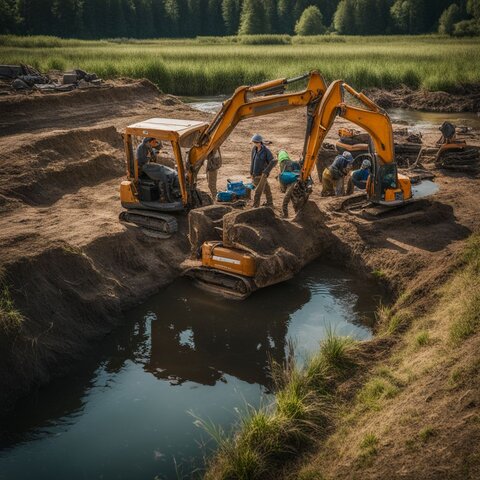
Prices can be higher or lower depending on where you live. In different states, the cost of digging out space for your pond varies too.
If you're looking at larger ponds, you might pay between $1.50 and $3.50 per cubic yard for excavation.
Hand-dug ponds could range from $2.50 to $7.50 per square foot due to local soil conditions and availability of contractors.
Now, let's talk about Pond Capacity.
Pond Capacity
Moving from geographic location, another key factor affecting the cost is pond capacity.
The amount of water a pond can hold directly influences your expenses. To calculate capacity, you measure the pond's width, length, and depth.
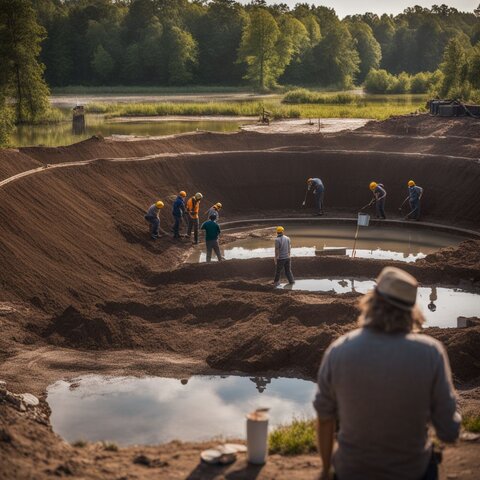
Larger ponds require more materials like liners and concrete, leading to higher costs.
They also might need stronger pumps and filtration systems to maintain water quality.
Choosing the right size for your needs helps control costs.
For example, a small garden pond needs less excavation work compared to a large fishing or swimming pond.
The type of soil in your area can affect this too; some soils are easier to dig than others.
In areas with hard rock or clay, digging becomes tougher and more expensive.
Remember that bigger ponds not only use more resources but also face greater environmental impacts over time.
Liner Material
After considering the capacity of your pond, it's vital to think about liner material.
Liner materials like HDPE, PVC, RPE, and EPDM rubber are crucial for waterproofing and ensuring your pond holds water effectively.
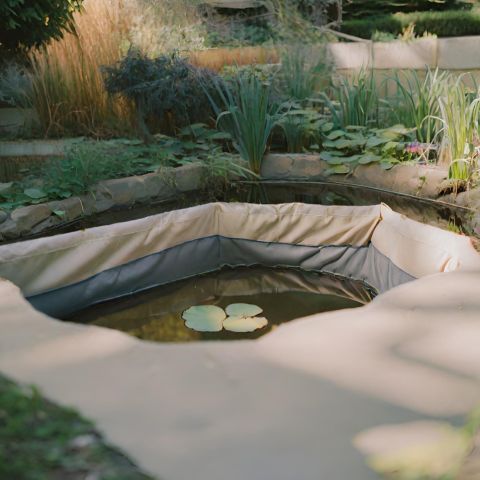
These materials vary in cost from $0.30 to $7.40 per square foot. Choosing the right one depends on your budget and the specific needs of your garden pond.
Fiberglass liners stand out for their durability and strength but might come with a higher price tag compared to other options.
Each material has its unique benefits—HDPE liners are known for high-density toughness against punctures, while EPDM rubber offers flexibility in shaping natural-looking ponds.
Your decision impacts both the initial setup cost and long-term maintenance needs of your water garden or ecological habitat.
Soil Type
Soil type greatly affects the cost of building a pond. Rocky or loose soil makes excavation harder, increasing labor costs.
Steep terrain also adds complexity and expense to the digging process.
In contrast, loamy soil might reduce excavation expenses due to its easier-to-dig nature.
Using specific liners like HDPE or Bentonite could either cut down or hike up your overall budget depending on how they interact with your soil's unique characteristics.
Next, let's discuss pumps and filters essential for maintaining your pond's ecosystem.
Pump and Filter
Just as the type of soil impacts your pond's foundation, the pump and filter system you choose plays a key role in maintaining its health.
Pond pumps can cost anywhere from $50 to $400.
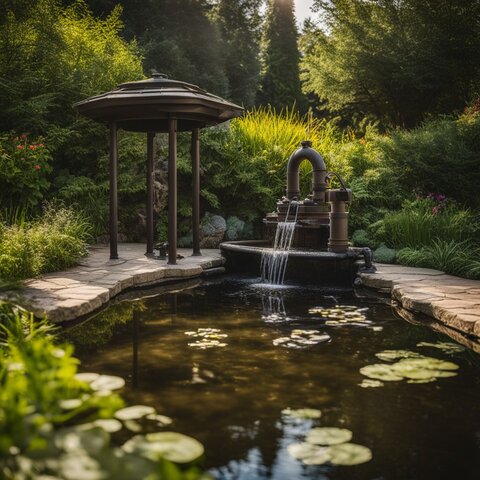
They ensure water circulates properly, reducing the chance of algae buildup and ensuring a healthy environment for fish and plants.
Filters are just as important and fall within the same price range.
They keep the water clean by trapping debris and promoting good oxygen levels.
Choosing the right pump and filter depends on your pond's volume and needs. Larger ponds require more powerful systems to move water effectively.
While shopping, look for options that match your pond’s size to avoid under or over-filtering.
Energy-efficient models can save money in the long run despite their higher upfront cost.
Remember, investing in quality equipment reduces maintenance costs and keeps your aquatic life thriving.
Additional Costs and Considerations
When planning your pond, remember to budget for extra expenses that can pop up.
Things like getting permits and adding decorations around your pond will affect the total cost.
Permits
Getting the right permits is a key step in building your pond.
If you disturb more than 5,000 square feet of land, expect to pay between $150 and $485 for excavation and grading permits.

These costs can vary depending on where you live and the size of your project.
Always check with local authorities to understand the specific requirements for your area.
Next, consider how stocking fish and plants will add life to your new pond.
Stocking the Pond with Fish and Plants
After securing permits, the next step is filling your pond with life. Stocking it with fish and plants adds beauty and balance to your aquatic ecosystem.
Fish like goldfish, koi, catfish, trout, and bass bring movement and color.

Prices for these fish range from $0.25 to $25 each. Choosing species that thrive in your pond's conditions ensures a vibrant, healthy environment.
Plants play a critical role too. They provide oxygen for fish, control algae growth, and enhance the pond's natural look.
Aquatic plants can cost between $4 and $55 per plant depending on their type.
Marginal plants priced from $6 to $40 are great for shallow areas around the edges.
Carefully selecting plants that suit your climate will keep maintenance costs down over time.
Landscaping Around the Pond
Landscaping around the pond makes everything look nice and can cost a lot.
You might spend between $8,000 to $15,000 to add plants, rocks, and maybe a path near your water feature.
If you decide to clear land around a 1-acre pond, this alone could cost up to $6,000.
Adding things like statues or fancy lights will make the area more special but also adds to the bill.
For those who love extra touches like fountains or waterfalls, remember these can push your expenses higher.
Costs for such add-ons range from just $10 for something simple up to $15,000 for very grand designs.
Planning for all these elements ensures your pond and its surroundings not only look beautiful but also fit within your budget.
Customizations for the Pond
Customizing your pond can greatly enhance its look and ecosystem.
Adding underwater lighting brings your pond to life at night, while installing a pond heater ensures fish thrive in colder weather.
You might also consider a rockery or retaining wall for aesthetic appeal and structure.
For those interested in biodiversity, adding emergent plants attracts frogs and beneficial insects to your garden ponds.
Fancy goldfish or largemouth bass can stock the pond, creating an engaging environment for both kids and adults.
Aeration systems improve water quality and help aquatic life flourish.
Choosing the right customizations depends on your goals, whether it’s supporting local wildlife or building a natural pool for swimming.
Maintenance of the Pond
Keeping a pond in good shape involves several tasks.
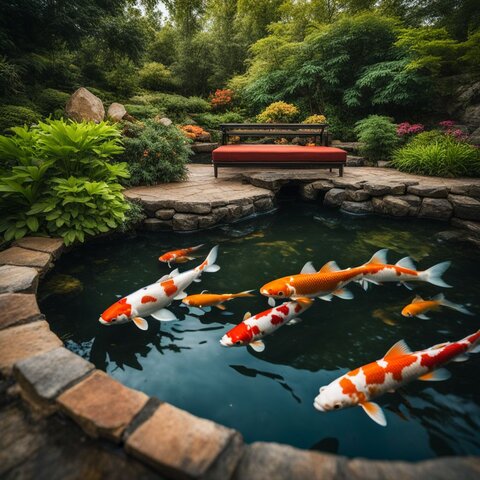
These include cleaning, controlling algae with filters, and feeding fish if you have them. You might spend between $450 to $5,000 yearly on these activities.
Costs depend on the size of your pond and how complex it is.
Adding things like fountains or lighting can also affect how much care your pond needs.
For example, pumps for water circulation range from \$50 to \$400 based on their type.
Remember that healthy ponds often mean happier fish and plants, leading to less work over time.
Next, let's discuss the different types of ponds and their costs.
Types of Ponds and Their Costs
The cost of building a pond varies based on its type. Each kind of pond serves a different purpose and has unique expenses.
Above-Ground Ponds
Above-ground ponds offer a cost-effective option for adding beauty and value to your property.
Prices for installing these types of ponds range from $1,900 to $6,500. For those who prefer the DIY route, you might spend between $550 and $6,100.
This kind of project requires careful planning but can significantly enhance your garden's appeal.
Having an above-ground pond could also boost your home's worth by 5% to 10%.
If ever needed, removing one depends on its size and construction materials.
Costs for removal include relocating any fish or wildlife and handling large stones or concrete liners.
Filling in a pond is another consideration, typically costing between $300 and $800.
Backyard Ponds
Backyard ponds can cost between $3,000 and $15,000 to build. This wide range depends on size, design, and the materials you choose.
For lining a pond, options like HDPE (high-density polyethylene), PVC (polyvinyl chloride), RPE (reinforced polyethylene), and EPDM (ethylene propylene diene monomer) are popular.
Each material has its own price tag and durability features.
Adding pumps and filters is essential for keeping the water clean and clear.
These can cost anywhere from $50 to $1,300. Remember that maintenance is key to a healthy pond ecosystem.
On average, maintaining your backyard oasis will set you back about $450 to $5,000 annually.
The investment not only enhances your property's beauty but also supports local wildlife and conserves water.
Farm Ponds
Building a farm pond costs between $2,000 and $10,000.
This price can go up depending on if you need to remove dirt, level the land, clear areas, or take out tree stumps.
You also might pay more for renting equipment like a mini-excavator which costs $200 to $700 per day.
Farm pond maintenance runs from $400 to $2,900 yearly.
Stocking your new pond with fish like bluegill will add another cost of about $800 to $1,500 per acre.
If you decide on a DIY approach for your farm pond construction, expect to spend anywhere from $550 to over $6,100 based on how big and detailed you want your pond to be.
Now let's explore fishing ponds and what they require in terms of budget and design.
Fishing Ponds
Shifting our focus to fishing ponds, these special bodies of water offer a unique blend of recreation and nature.
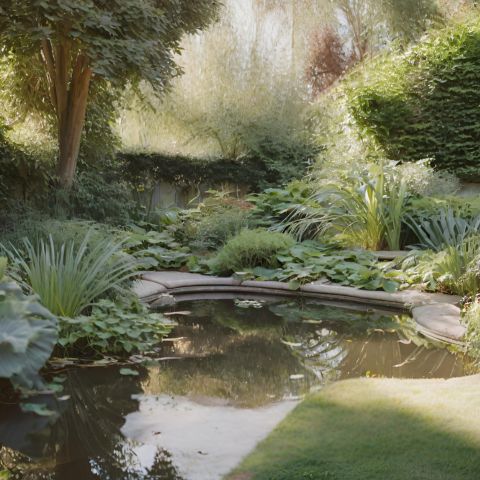
The cost to build one largely depends on size and whether it's stocked with fish.
Stocking a large recreational pond with fish can range from $800 to $1,500 per acre.
This includes a variety of species like sunfish or bass, creating a balanced ecosystem for anglers to enjoy.
Additionally, the expenses don't stop at stocking the pond.
Monthly maintenance such as cleaning, feeding the fish, and ensuring the water quality remains high can cost between $450 to $5,000 yearly.
These costs help maintain a healthy environment for both fish and plants in the pond while keeping it enjoyable for fishing enthusiasts year-round.
Koi Ponds
Building a koi pond involves several key factors that affect the price.
The cost might start below $1,000 for small DIY projects but can quickly soar to tens of thousands for big, intricately designed ponds.
Size, capacity, and location play huge roles in determining how much you will spend.
Liner materials like HDPE or EPDM are crucial choices because they impact longevity and health of your fish.
Pumps and filters are essential for keeping the water clean and clear, adding more to the expense.
Stocking your pond with koi can also be pricey since each fish could cost between $10 to $60 depending on their type and size.
Adding heaters, lighting, or even bridges not only increases beauty but also the overall investment needed for creating a picturesque aquatic haven.
Next, let's dive into lakes and understand their costs and considerations.
Lakes
Creating a man-made lake costs more than other types of ponds due to its size and complexity.
Size is a major factor, as larger bodies of water require more excavation, which can range from $1.50 to $3.50 per cubic yard for big projects.
The location also plays a key role in cost; areas that are hard to reach with machinery or need a lot of land clearing will increase expenses.
Lakes need special liners to prevent water loss, often made from high-quality materials like thermoplastic polymer.
These liners ensure the lake holds water efficiently but add to the overall cost.
Additionally, creating an ecosystem with fish and plants involves extra spending, ranging from a few cents to hundreds of dollars depending on species and quantity needed.
Natural Swimming Ponds
Building a natural swimming pond costs up to $80,000. These ponds are unique because they combine the beauty of nature with the fun of swimming.
They need a careful design that includes a zone for plants and another for swimming.
This makes them more complex and usually requires professional builders.
Before you start, you must check if permits are needed in your area. Permits ensure your pond meets local regulations and safety standards.
Also, consider the land where you want to build your pond.
The soil type and geographical location can affect the cost and design of your natural swimming pond.
Benefits of Building a Pond
When planning your pond, also consider its ecological impact and how you can enhance local biodiversity, such as by choosing native plants and creating habitats for wildlife.
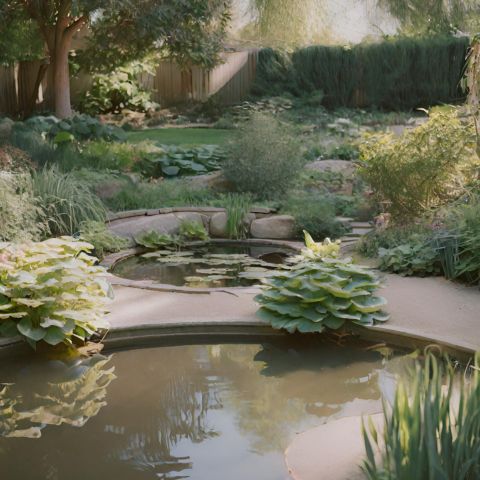
It supports local wildlife, making your garden a haven for various species while promoting healthier soil without extra fertilizers.
Water Conservation
Ponds play a crucial role in saving water.
They capture rainwater, reducing the need for artificial irrigation and helping to fight climate change by conserving precious water resources.
This natural collection process not only supports local plants and wildlife but also promotes groundwater recharge, cutting down on soil erosion.
Using native plants around your pond maximizes its benefits for water conservation.
These plants are better at retaining water, minimizing evaporation rates significantly.
Proper maintenance ensures your pond remains an effective tool for conserving water, contributing positively to the environment while enhancing your property's value and beauty.
Carbon Sequestration
Moving from the topic of water conservation, building a pond also plays a significant role in carbon sequestration.
This process helps fight climate change by capturing and storing carbon dioxide.
Ponds act as carbon sinks, absorbing more carbon than they release. This reduces the overall carbon footprint of an area.
Through photosynthesis, plants in and around the pond pull CO2 from the air, using it to grow.
The soil at the bottom of ponds stores large amounts of organic matter, which includes captured carbon.
Over time, this can significantly reduce greenhouse gas emissions into the atmosphere.
Making ponds becomes not just about enhancing land value or creating natural pools but also about contributing positively to the environment by reducing carbon emissions.
Supporting Local Wildlife
Building a pond creates a welcoming environment for local wildlife. Fish, frogs, turtles, and insects find new homes in these water gardens.

This addition to your yard turns it into a thriving ecosystem where creatures can flourish.
Ponds also help with organic gardening by attracting beneficial insects that pollinate plants.
Birds often visit for a drink or bath, adding beauty and life to the garden.
With careful planning, your pond will support nature's balance, making your outdoor space more vibrant and alive.
Reducing Fertilizing and Mowing Requirements
Having a pond cuts down on the amount of work your lawn needs. It keeps the need for fertilizing and mowing low.
This makes caring for your outdoor space easier and less costly over time.
Ponds help in controlling weeds naturally. You won't have to use as many chemicals to keep things looking good.
This eco-friendly feature supports a sustainable environment right in your backyard.
Less lawn maintenance means more savings and a healthier place for everyone to enjoy.
Now, let's explore how ponds improve energy efficiency around your home.
Energy Efficiency
Building a pond can lead to energy efficiency benefits. By reducing the need for mowing, you save on fuel and machinery use.
This makes ponds a smart choice for people looking to cut down on energy consumption.
The type of pump and filter you choose also plays a role in how energy efficient your pond will be.
Opting for models that are designed to conserve energy can help lower overall costs and support a healthier environment.
Choosing the right equipment is crucial for maximizing these benefits.
High-quality pumps and filters not only clean the water efficiently but also run on less power than lesser quality options.
This reduces electricity usage over time, contributing to the pond’s positive impact on energy savings.
Always consider these factors when planning your pond to ensure it aligns with goals for both beauty and sustainability.
DIY vs. Hiring a Professional for Pond Building
Even if you decide on a DIY approach, consider consulting with a pond construction professional to avoid common pitfalls and ensure your pond is built safely and sustainably.
A DIY kit for a garden pond might cost under $1,000.
This option lets you control the budget and design. However, creating an 8x11 feet garden pond by yourself costs around $3,005.
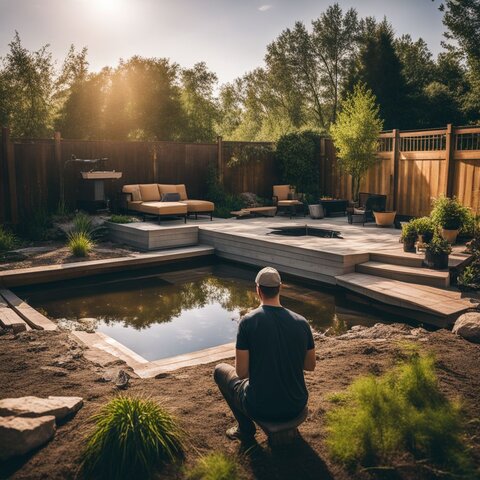
You'll need to buy materials like a pond liner, pump and filter.
Hiring professional pond builders costs more but comes with benefits. They know how to handle risks and have the right tools.
Professionals ensure your pond meets safety standards and prevents water damage or flooding.
They also follow guidelines from bodies like the US Army Corps of Engineers. Hiring experts is best to avoid future issues with your beautiful new addition.
How to Save Money on Pond Building Costs
Saving money on building a pond is possible with careful planning and smart choices.
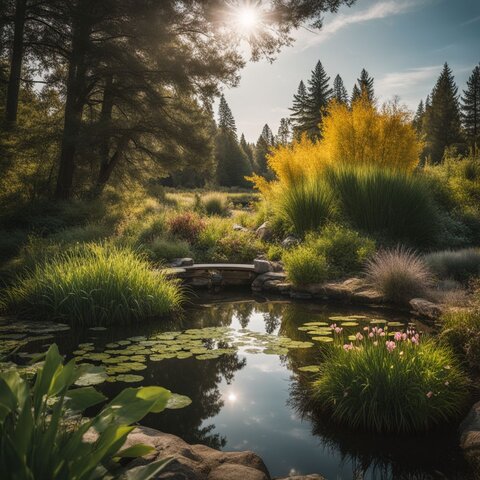
Here are some strategies to keep costs down:
- Choose a smaller size for your pond. This reduces excavation and liner material costs.
- Opt for a shallower depth to save on excavation fees which can range from $60 to $200 per cubic yard of dirt.
- Use a DIY pond kit instead of hiring professionals, knowing that labor can cost between $500 and $12,000.
- Select economical liner materials such as plastic or HDPE, which are among the options with varying costs per square foot.
- Install the pump and filter yourself. Prices for pumps range from $50 to $400, and filters also fall within this price range, offering potential savings.
- Limit custom features like waterfalls or fancy illumination, which increase overall expenses.
- Landscape with native plants to cut down on costs related to turf and exotic flora maintenance around the pond.
- Consider manual excavation if feasible, to avoid the hourly rates of using machinery like backhoes.
- Gather multiple quotes for any work you can't do yourself to ensure competitive pricing on services and materials.
- Reuse or repurpose materials whenever possible. Look around for stones, rocks, or even plants that can be used in your pond setting.
FAQs
What is the national average cost to build a pond?
The national average cost to build a pond can vary, but it often depends on the size and type of pond you want.
Can I have a swimming pool or fish farming pond in my yard?
Yes, you can choose to build either a swimming pool for fun or a fish farming pond in your front yard or anywhere on your lawns.
Do ponds help with stormwater runoff?
Yes, ponds can help manage stormwater runoff by collecting rainwater which might otherwise flood areas like lawns and gardens.
What should I consider before building a pond?
Before building a pond, think about its purpose, whether for an aquarium look, swimming, or something else. Also consider geotechnical factors such as topsoil quality.
Are there special features I can add to my pond?
You can add many features to your man-made lakes or ponds such as a pool skimmer to keep the water clean and filtered.
Conclusion
How much does it cost to build a pond is a good question if you are considering building one.
Building a pond offers many benefits, from supporting wildlife to saving water.
Costs can vary widely, starting at under $1,000 for simple DIY projects to tens of thousands for large or complex ponds.
Factors like size, location, and materials play big roles in determining the final price.
Keep these in mind as you plan your pond to make the most of your budget and outdoor space.

